I am aghast, alarmed, astounded, shocked, and horrified. If pushed, I might admit to being flabbergasted (rarely has my flabber been so gasted). If I were feeling uncouth, I might even go so far as to say I was gobsmacked. How could something as awesome as what I am about to discuss have existed for so long without my knowing anything about it?
These days, audio experiences have grown to be a major part of our daily lives — not just listening to high-fidelity music coming out of incredibly small speakers in our homes, but also basking in the glow of sumptuous soundscapes in our cars and wandering through the world employing voice control of our smart devices. The fact that I can recline in my command chair in our family room and ask Alexa to activate the television and then locate a program to divert and delight me without my having to lift a finger would have been the stuff of science fiction just a few short years ago.
The funny thing is that — as pervasive as audio has become — I must admit to having given little thought as to how these systems are conceived and created. So, you can only imagine my surprise and delight to be introduced to the folks at DSP Concepts and their Audio Weaver technology.
In fact, I just spent a happy afternoon chatting with DSP Concepts’ Founder and CTO, Dr. Paul Beckmann, and Director of Marketing, Adam Levenson. All I can say is that Paul and Adam opened my eyes (and ears) to a brave new world called the Audio of Things (AoT). In a crunchy nutshell, the AoT represents the totality of audio processing technologies that deliver remarkable audio experiences — including voice control, voice communications, playback, and sensing — encapsulated in a wide range of products. Unlike conventional audio feature development, DSP Concepts offers products and services for the AoT that are processor agnostic and fully customizable.
As an aside, I should perhaps point out that, here on EEJournal, Bryon Moyer has covered DSP Concepts and Audio Weaver almost since their conception and inception circa 2015 in his columns A Tool for Designing Audio Subsystems (2015), Audio Processing Evolves Like Chip Design (2018), and The Problem with Microphones (2019). Of course, this makes it all the more embarrassing that I managed to remain so blissfully unaware of this technology for so long. If it’s true that “ignorance is bliss,” as the old saying goes, then I must be one of the happiest men on the planet.
So, here’s the deal, if you look at almost any engineering discipline other than audio, you’ll find that there are frameworks and design environments to help you do your work efficiently and productively. If you wish to create a website, for example, you don’t start capturing raw HTML using a cheap-and-cheerful text editor like Notepad; instead, you employ a modern web developer’s platform like Angular. Similarly, if you intend to construct a touch control panel, you don’t begin by building all of the graphics drivers from the ground up; instead, you use a graphics library and a widget toolkit like Qt. As one final example, if you are embarking on an artificial intelligence (AI) and machine learning (ML) project, you don’t handcraft your own artificial neural network (ANN) from scratch; instead, you leverage a framework like TensorFlow.
Are you with me so far? I didn’t hear you. Let’s try that again. ARE YOU WITH ME SO FAR? That’s better. Now, let’s assume that you are in charge of creating the audio portion of a product — perhaps you wish to add audio control to an appliance or a spiffy sound system to a new automobile. How are you going to do this? Many developers who aren’t “in the know” (because they have not yet read this column) start redesigning the wheel, which is silly if they wish to end up with a sound system.
Suppose the system involves an array of microphones. In this case, you are going to need functions like noise reduction and echo cancelling and beam forming. If you have one or more loudspeakers in the system, you are almost certainly going to employ equalization, compressor, and limiter functions. This is where Audio Weaver leaps onto the center stage with an electrifying shemozzle of Zeusaphones (don’t stand too close).
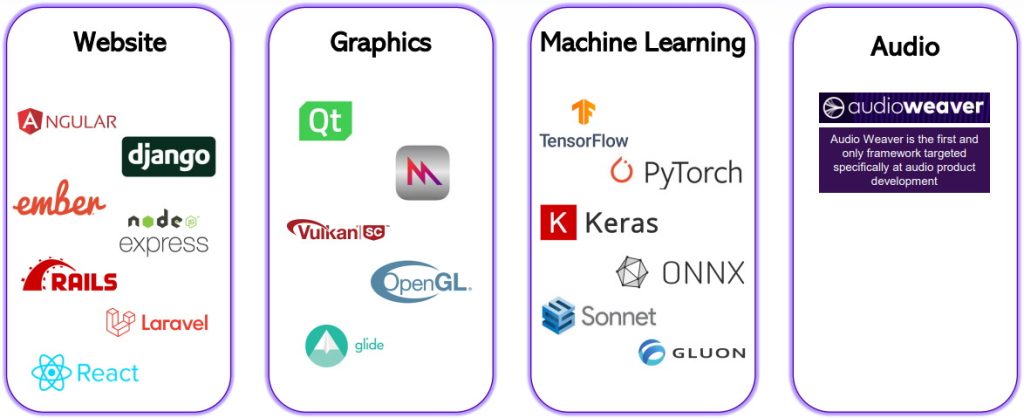
Frameworks are a standard part of engineering (Image source: DSP Concepts)
As we glean from this illustration — and as Paul and Adam informed me — Audio Weaver is the first and only framework targeted specifically at audio product development.
As an aside, I’m not an audio authority; I know only enough to be dangerous. For example, I was reasonably familiar with the concept of equalization (adjusting the volume of different frequency bands within an audio signal), but less so with the concepts of audio compressors and limiters.
Since I’m a digital design engineer by trade, when I hear the term “compression,” I think of lossy or lossless data compression that results in fewer bits than the original representation. In the case of the compressors we’re discussing here, however, we’re talking about dynamic compression that reduces the span between the softest and loudest sounds, thereby evening out the quieter and louder parts of an audio stream so that both can be heard clearly.
Similarly, when I first heard the term “limiter,” I was thinking of the coarse clipping off the top of any loud parts of the waveform as was the norm in my youth, and I know how this can make things sound horrible. By comparison, in the case of today’s systems, a limiter function evaluates the amplitude (volume) of an input signal and — for any peaks that exceed a threshold value — it attenuates (lowers) those peaks without clipping. Color me impressed.
Returning to Audio Weaver, as illustrated below, this bodacious beauty boasts an intuitive and easy-to-use drag-and-drop graphical interface that runs on a PC. The Standard Edition is GUI only, while the Pro Edition also works in conjunction with MATLAB.
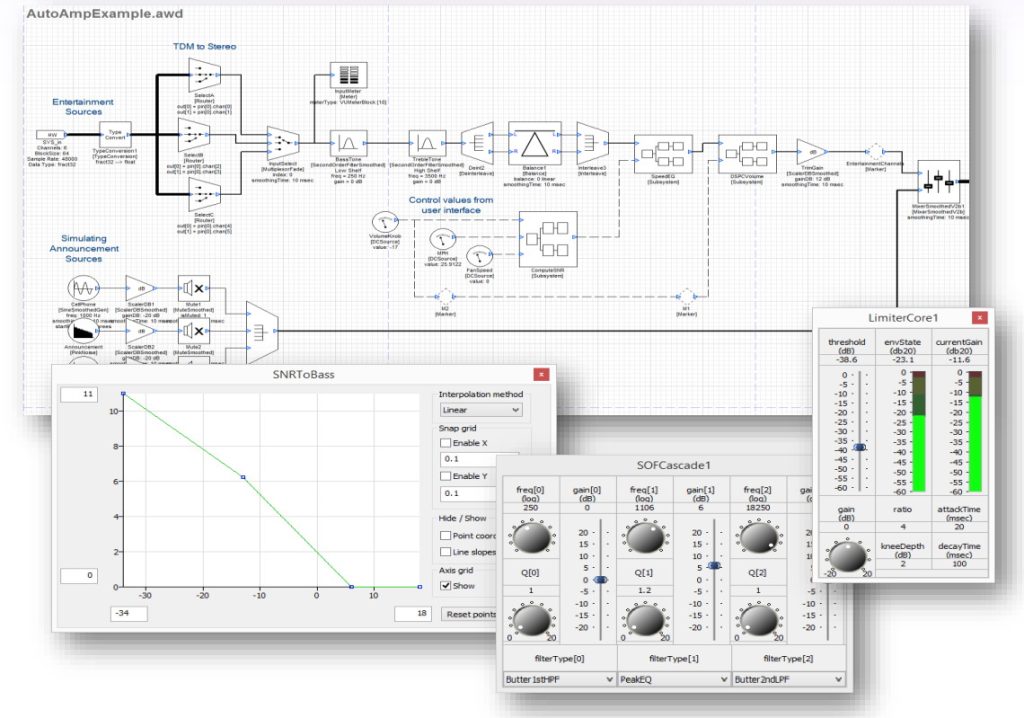
Audio Weaver boasts an intuitive and easy-to-use drag-and-drop graphical interface (Image source: DSP Concepts)
There’s also an associated runtime core that comes equipped with highly optimized target-specific libraries for use on a wide range of processors from ARM, Cadence, CEVA, TI, Qualcomm… the list goes on (and on, and on).
I’ll tell you what, why don’t we take a few minutes’ break. You take a look at this Audio Weaver video from CES 2022 while I grab a quick coffee.
And I’m back! There is a range of folks designing audio systems, from gurus who know everything there is to know to people designing products for which they desire a turnkey solution. Audio Weaver supports them all. In addition to preconfigured solutions (customers can customize these starting points to create bespoke offerings) for things like soundbars, televisions, elevators, appliances, cars… the folks at DSP Concepts also offer design services to develop the audio portion of products if required.
DSP Concepts also boasts a wide range of chip partners with prototyping platforms and reference designs like the TalkTo voice user interface for human-to-machine communication and the TalkTogether voice communication interface for human-to-human communication.
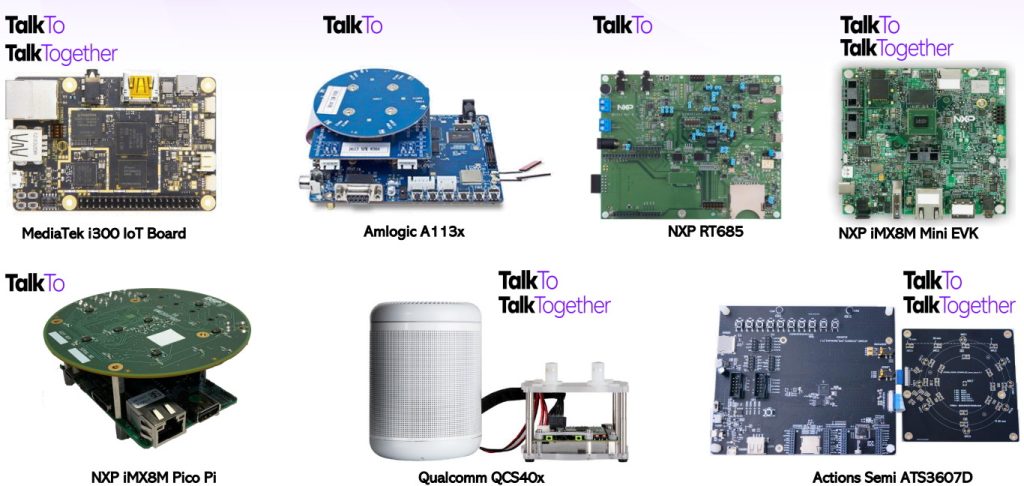
Chip partners and reference designs (Image source: DSP Concepts)
It was at this point that the folks at DSP Concepts blew me away by showing me an image that was jam-packed with “stuff” reflecting just a small sampling of the companies (and associated products) that use Audio Weaver to realize their audio solutions (sad to relate, a few of these items are confidential so I cannot share this image here).
My knee-jerk reaction was to think, “This is ridiculous! If Audio Weaver is used to create the hidden secret audio sauce in all of these products, how come I haven’t heard (no pun intended) about it before?” It turns out that, until relatively recently, many users preferred to keep this sort of thing secret. It also appears that those days are gone — as are the days in which the audio aspects of a device were sadly neglected — as is exemplified by the fact that many of the companies leading the AoT charge are now requesting Audio Weaver expertise as one of their requirements for prospective employees (the highlighted areas in the image below specify the prerequisite for prowess and proficiency in the art of Audio Weaver).
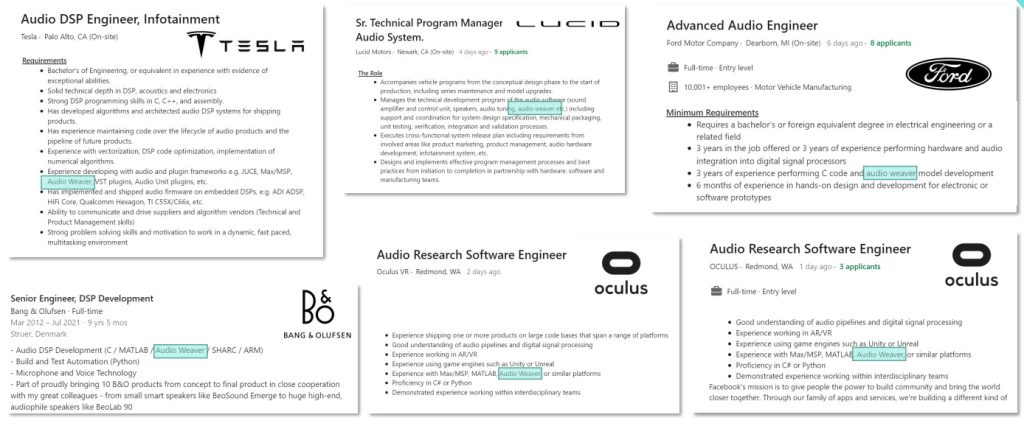
The AoT is being adopted by leading companies (Image source: DSP Concepts)
As I pen these words, audio is evolving in front of our eyes (well, ears). The bottom line is that pretty much anywhere there’s a microphone and/or a speaker, Audio Weaver can help developers create fabulous next-generation experiences. As the folks at DSP Concepts like to say: “Don’t reinvent the wheel — invent the future!” What say you? Were you already au fait with DSP Concepts and Audio Weaver, or was this as big a surprise for you as it was for me?


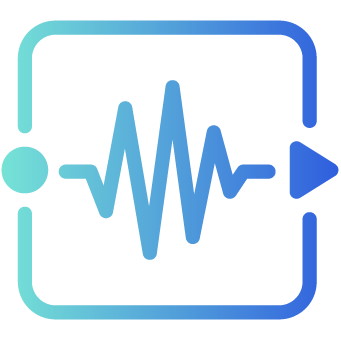



One thought on “You Too Can Rule the AoT with Audio Weaver”